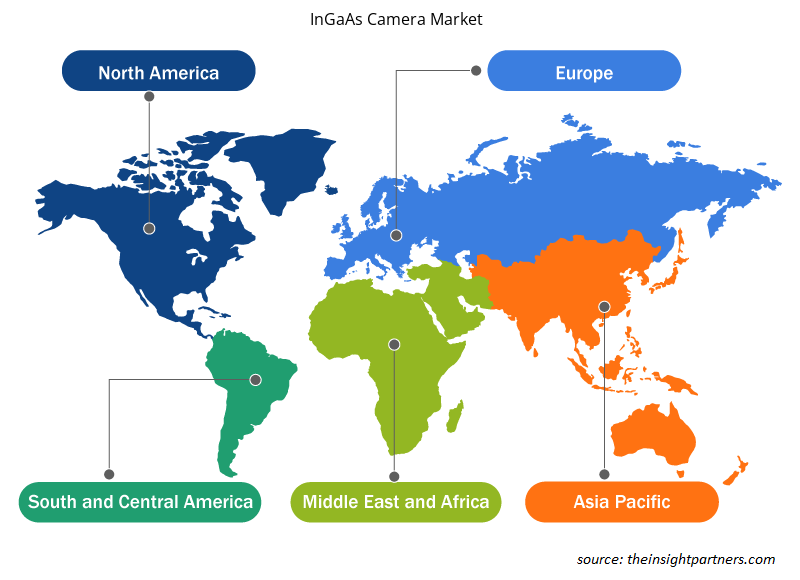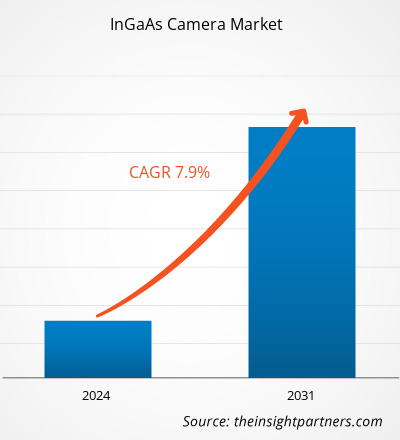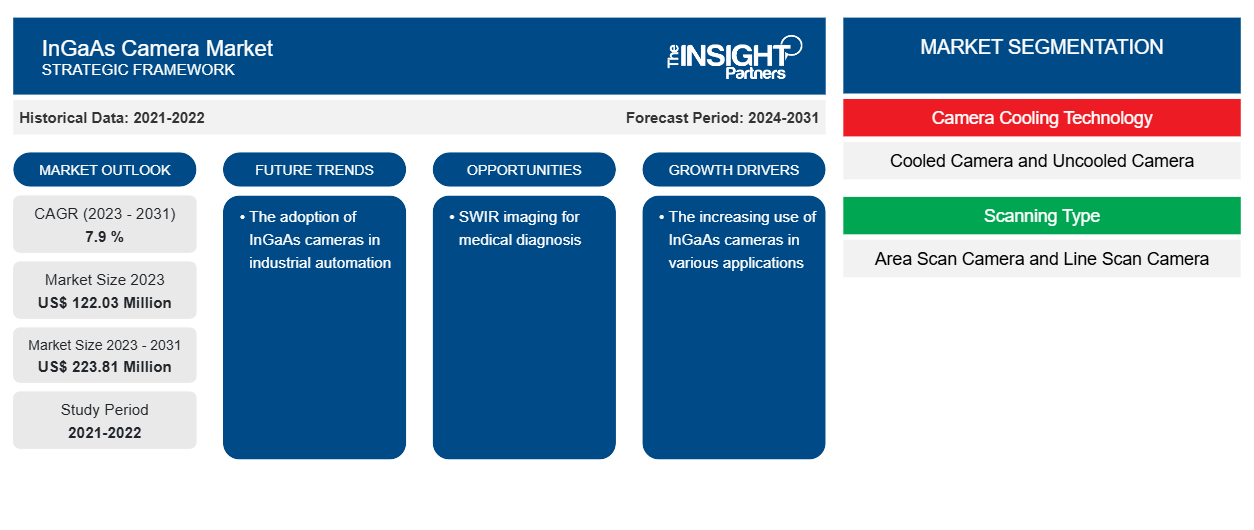Si prevede che la dimensione del mercato delle telecamere InGaAs raggiungerà i 223,81 milioni di dollari entro il 2031, rispetto ai 122,03 milioni di dollari del 2023. Si prevede che il mercato registrerà un CAGR del 7,9% nel periodo 2023-2031. È probabile che l'adozione di telecamere InGaAs nell'automazione industriale rimanga una tendenza chiave nel mercato.
Analisi del mercato delle fotocamere InGaAs
La crescita del mercato delle telecamere InGaAs è attribuita al crescente utilizzo di queste telecamere in varie applicazioni, come l'automazione industriale e la diagnosi medica . Una telecamera SWIR può prevenire questo problema e quindi garantire un processo di produzione regolare. Pertanto, l'aumento dell'utilizzo delle telecamere InGaAs in varie applicazioni sta guidando il mercato delle telecamere InGaAs. Vengono inoltre discusse tecniche di imaging SWIR, come l'imaging iperspettrale SWIR per applicazioni biomediche e un sistema microscopico olografico digitale a banda larga (VIS+SWIR) basato su un nuovo sensore di immagini a punti quantici (QD). Pertanto, l'aumento dell'utilizzo delle telecamere InGaAs in varie applicazioni sta guidando il mercato.
Panoramica del mercato delle fotocamere InGaAs
I sensori InGaAs sono utilizzati per la rilevanza nelle scienze fisiche e biologiche e richiedono un'elevata sensibilità nell'intervallo di lunghezza d'onda 900-1700 nm, noto come infrarosso a onde corte (SWIR). Alcuni sensori InGaAs possono misurare fino a 2500 nm a causa delle modifiche nella composizione del materiale. Sebbene le telecamere CCD basate sul silicio possiedano sensibilità nell'intervallo UV-NIR, le proprietà di bandgap del silicio impediscono a queste CCD di avere una sensibilità sufficiente oltre 1100 nm. Le telecamere InGaAs hanno un bandgap inferiore, rendendo questo materiale il materiale preferito per applicazioni nella regione dell'infrarosso a onde corte (SWIR).
Personalizza questo report in base alle tue esigenze
Riceverai la personalizzazione gratuita di qualsiasi report, comprese parti di questo report, o analisi a livello nazionale, pacchetto dati Excel, oltre a usufruire di grandi offerte e sconti per start-up e università
- Scopri le principali tendenze di mercato in questo rapporto.Questo campione GRATUITO includerà analisi di dati che spaziano dalle tendenze di mercato alle stime e alle previsioni.
Driver e opportunità del mercato delle fotocamere InGaAs
L'uso crescente di telecamere InGaAs in varie applicazioni
L'ispezione di cristalli e lingotti di silicio (noti anche come mattoni) è una delle applicazioni più popolari per le telecamere InGaAs nel settore dei semiconduttori. La capacità di vedere nel silicio a una gamma di lunghezze d'onda superiore a 1.150 nm fornisce alle telecamere InGaAs una soluzione adatta per il rilevamento di inclusioni, come impurità all'interno di un cristallo o di un lingotto, che possono accumularsi durante il processo di produzione. Le impurità sono critiche quando si osservano i lingotti in sottili wafer con una catena di diamante. Se la catena colpisce un elemento, come un piccolo pezzo di metallo, la catena eccezionalmente costosa può rompersi. Non solo la sostituzione di una catena genera un costo, ma porta anche a una minore produttività e a profitti ridotti. Una telecamera SWIR può prevenire ciò e quindi garantire un processo di produzione regolare. Pertanto, l'aumento dell'uso di telecamere InGaAs in varie applicazioni sta guidando il mercato delle telecamere InGaAs.
Immagini SWIR per diagnosi medica
L'imaging SWIR è utilizzato nella diagnosi medica. Le tecniche in via di sviluppo basate sulla luce SWIR, tra cui la fabbricazione e l'uso di nanoparticelle SWIR come agenti fototermici e nanotermometri luminescenti, e i recenti progressi nella struttura, progettazione e applicazioni biomediche correlate a SWIR di nanoparticelle drogate con terre rare (REDN). Le REDN sono tra gli emettitori SWIR più altamente luminosi e biocompatibili. Vengono inoltre discusse le tecniche di imaging SWIR, come l'imaging iperspettrale SWIR per applicazioni biomediche e un sistema microscopico olografico digitale a banda larga (VIS+SWIR) basato su un nuovo sensore di immagini a punti quantici (QD). Pertanto, l'aumento dell'uso di telecamere InGaAs in varie applicazioni sta guidando il mercato.
Analisi della segmentazione del rapporto di mercato delle fotocamere InGaAs
I segmenti chiave che hanno contribuito alla derivazione dell'analisi di mercato delle telecamere InGaAs sono la tecnologia di raffreddamento della telecamera, il tipo di scansione e l'applicazione.
- In base alla tecnologia di raffreddamento della fotocamera, il mercato delle fotocamere InGaAs è suddiviso in fotocamere raffreddate e fotocamere non raffreddate. Il segmento software ha detenuto una quota di mercato maggiore nel 2023.
- In base al tipo di scansione, il mercato è segmentato in telecamere a scansione d'area e telecamere a scansione lineare.
- In base all'applicazione, il mercato è segmentato in militare e difesa, automazione industriale e ricerca scientifica.
Analisi della quota di mercato delle fotocamere InGaAs per area geografica
L'ambito geografico del rapporto sul mercato delle fotocamere InGaAs è suddiviso principalmente in cinque regioni: Nord America, Asia Pacifico, Europa, Medio Oriente e Africa, Sud e Centro America.
L'APAC domina il mercato delle telecamere InGaAs. La crescente domanda di adozione dell'automazione nelle industrie, i test non distruttivi e la crescente adozione di applicazioni di visione artificiale dovrebbero guidare la crescita del mercato delle telecamere InGaAs durante il periodo di previsione.
Approfondimenti regionali sul mercato delle fotocamere InGaAs
Le tendenze regionali e i fattori che influenzano il mercato delle fotocamere InGaAs durante il periodo di previsione sono stati ampiamente spiegati dagli analisti di Insight Partners. Questa sezione discute anche i segmenti e la geografia del mercato delle fotocamere InGaAs in Nord America, Europa, Asia Pacifico, Medio Oriente e Africa e America meridionale e centrale.InGaAs Camera Market throughout the forecast period have been thoroughly explained by the analysts at Insight Partners. This section also discusses InGaAs Camera Market segments and geography across North America, Europe, Asia Pacific, Middle East and Africa, and South and Central America.

- Ottieni i dati specifici regionali per il mercato delle fotocamere InGaAs
Ambito del rapporto sul mercato delle fotocamere InGaAs
| Attributo del report | Dettagli |
|---|---|
| Dimensioni del mercato nel 2023 | 122,03 milioni di dollari USA |
| Dimensioni del mercato entro il 2031 | 223,81 milioni di dollari USA |
| CAGR globale (2023-2031) | 7,9% |
| Dati storici | 2021-2022 |
| Periodo di previsione | 2024-2031 |
| Segmenti coperti | Con la tecnologia di raffreddamento della telecamera
|
| Regioni e Paesi coperti | America del Nord
|
| Leader di mercato e profili aziendali chiave |
|
Densità degli attori del mercato: comprendere il suo impatto sulle dinamiche aziendali
Il mercato delle fotocamere InGaAs sta crescendo rapidamente, spinto dalla crescente domanda degli utenti finali dovuta a fattori quali l'evoluzione delle preferenze dei consumatori, i progressi tecnologici e una maggiore consapevolezza dei vantaggi del prodotto. Con l'aumento della domanda, le aziende stanno ampliando le loro offerte, innovando per soddisfare le esigenze dei consumatori e capitalizzando sulle tendenze emergenti, il che alimenta ulteriormente la crescita del mercato.
La densità degli operatori di mercato si riferisce alla distribuzione di aziende o società che operano in un particolare mercato o settore. Indica quanti concorrenti (operatori di mercato) sono presenti in un dato spazio di mercato in relazione alle sue dimensioni o al valore di mercato totale.
Le principali aziende che operano nel mercato delle telecamere InGaAs sono:
- Fotonica di Hamamatsu KK
- Tecnologie di visione alleate GmbH
- Nuove tecnologie di imaging
- Strumenti Pembroke LLC
- Azienda Polytec GmbH
- Raptor Fotonica Limitata
Disclaimer : le aziende elencate sopra non sono classificate secondo un ordine particolare.

- Ottieni una panoramica dei principali attori del mercato delle fotocamere InGaAs
Notizie e sviluppi recenti sul mercato delle fotocamere InGaAs
Il mercato delle fotocamere InGaAs viene valutato raccogliendo dati qualitativi e quantitativi dopo la ricerca primaria e secondaria, che include importanti pubblicazioni aziendali, dati associativi e database. Di seguito sono elencati alcuni degli sviluppi nel mercato delle fotocamere InGaAs:
- Hamamatsu Photonics, fornitore leader di tecnologie e prodotti fotonici all'avanguardia, ha introdotto una nuova fotocamera InGaAs con sensibilità nella regione del visibile e del vicino infrarosso, da 400 nm a 1700 nm. (Fonte: Hamamatsu Photonics, comunicato stampa, febbraio 2024.)
- BlueVision Ltd., Giappone ha lanciato una nuova telecamera a scansione lineare SWIR da 1K denominata BV-C3110, che è un nuovissimo sensore InGaAs da 1K nell'aprile 2021 (Fonte: BlueVision Ltd, comunicato stampa, aprile 2021)
Copertura e risultati del rapporto sul mercato delle fotocamere InGaAs
Il rapporto "Dimensioni e previsioni del mercato delle fotocamere InGaAs (2021-2031)" fornisce un'analisi dettagliata del mercato che copre le seguenti aree:
- Dimensioni e previsioni del mercato delle fotocamere InGaAs a livello globale, regionale e nazionale per tutti i segmenti di mercato chiave coperti dall'ambito
- Tendenze del mercato delle telecamere InGaAs, nonché dinamiche di mercato come driver, sistemi di ritenuta e opportunità chiave
- Analisi dettagliata delle cinque forze PEST/Porter e SWOT
- Analisi del mercato delle fotocamere InGaAs che copre le principali tendenze del mercato, il quadro globale e regionale, i principali attori, le normative e i recenti sviluppi del mercato
- Analisi del panorama industriale e della concorrenza che copre la concentrazione del mercato, l'analisi della mappa di calore, i principali attori e gli sviluppi recenti per il mercato delle fotocamere InGaAs
- Profili aziendali dettagliati
- Analisi storica (2 anni), anno base, previsione (7 anni) con CAGR
- Analisi PEST e SWOT
- Valore/volume delle dimensioni del mercato - Globale, Regionale, Nazionale
- Industria e panorama competitivo
- Set di dati Excel
Report recenti
Rapporti correlati
Testimonianze
Motivo dell'acquisto
- Processo decisionale informato
- Comprensione delle dinamiche di mercato
- Analisi competitiva
- Analisi dei clienti
- Previsioni di mercato
- Mitigazione del rischio
- Pianificazione strategica
- Giustificazione degli investimenti
- Identificazione dei mercati emergenti
- Miglioramento delle strategie di marketing
- Aumento dell'efficienza operativa
- Allineamento alle tendenze normative





















 Ottieni un campione gratuito per - Mercato delle fotocamere InGaAs
Ottieni un campione gratuito per - Mercato delle fotocamere InGaAs